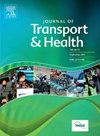Deconstructing the barriers and facilitators of e-bike helmet usage: A structural equation modeling approach
IF 3.2
3区 工程技术
Q2 PUBLIC, ENVIRONMENTAL & OCCUPATIONAL HEALTH
引用次数: 0
Abstract
Introduction
E-bike accidents are on the rise in China as shared e-bikes become more popular. Helmet usage could prevent e-bike riders from severe head injuries in e-bike accidents. Investigating the underlying determinants that influence the intention towards helmet use is of paramount importance.
Methods
Drawing upon the theoretical underpinnings of the Theory of Planned Behavior, this study puts forth an augmented framework to analyze a dataset comprising responses from 1300 shared e-bike users in Guangzhou, China. By employing structural equation modeling, we aim to pinpoint the pivotal factors influencing helmet use intention, with a particular emphasis on attitudes, punishments for not wearing helmets, subjective norms, safety awareness, personal characteristics, and service level of helmets.
Result
Attitudes, punishments, subjective norms, safety awareness, and service level were identified as five statistically significant factors. Among these, the most potent determinant of an individual's intention to use a helmet was found to be their underlying attitude towards this safety measure. The first two factors (attitudes and punishments) have direct effects on helmet use intention, while the other three determinants have indirect effects that are mediated by attitudes.
Conclusions
Promoting positive attitudes toward helmet use may be more effective than other factors for encouraging their adoption among shared e-bikers. Positive attitudes can be fostered by establishing a helmet-use behavioral norm, increasing shared e-bikers’ safety awareness, and improving helmet quality provided by merchants. As a result of the findings, the current penalty for not wearing a helmet may need to be adjusted to motivate more people to wear helmets.
解构电动自行车头盔使用的障碍和促进因素:结构方程建模方法
随着共享电动自行车越来越受欢迎,中国的电动自行车事故呈上升趋势。戴头盔可以防止电动自行车使用者在电动自行车事故中头部严重受伤。调查影响头盔使用意向的潜在决定因素至关重要。基于计划行为理论的理论基础,本研究提出了一个增强框架来分析包含中国广州1300名共享电动自行车用户反馈的数据集。通过结构方程模型,我们旨在找出影响头盔使用意愿的关键因素,特别强调态度,不戴头盔的惩罚,主观规范,安全意识,个人特征和头盔的服务水平。结果态度、处罚、主观规范、安全意识和服务水平被确定为五个具有统计学意义的因素。其中,最有效的决定因素一个人的意图使用头盔被发现是他们对这一安全措施的潜在态度。前两个因素(态度和惩罚)对头盔使用意愿有直接影响,而其他三个决定因素有间接影响,由态度介导。结论促进对头盔使用的积极态度可能比其他因素更有效地鼓励共享电动自行车用户采用头盔。通过建立头盔使用行为规范,提高共享电动自行车骑行者的安全意识,提高商家提供的头盔质量,可以培养积极的态度。由于这些发现,目前对不戴头盔的处罚可能需要调整,以激励更多的人戴头盔。
本文章由计算机程序翻译,如有差异,请以英文原文为准。
求助全文
约1分钟内获得全文
求助全文

 求助内容:
求助内容: 应助结果提醒方式:
应助结果提醒方式:


